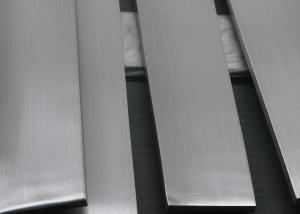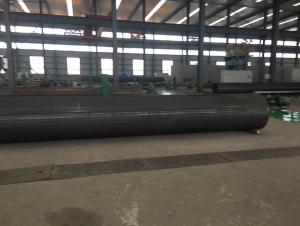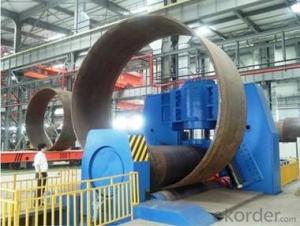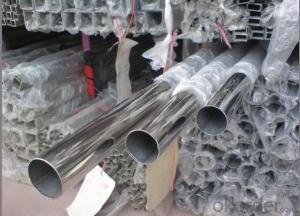Large Diameter Stainless Steel Pipe for Wholesales
- Loading Port:
- Tianjin
- Payment Terms:
- TT OR LC
- Min Order Qty:
- 35 m.t.
- Supply Capability:
- 3000 m.t./month
OKorder Service Pledge
OKorder Financial Service
You Might Also Like
Specification
Large Diameter Stainless Steel Pipe for Wholesales
1.Structure of Stainless Steel Pipe :
Stainless steel pipe is formed by drawing a solid billet over a piercing rod to create the hollow shell. As the manufacturing process does not include any welding, seamless pipes are perceived to be stronger and more reliable. Historically seamless pipe was regarded as withstanding pressure better than other types, and was often more easily available than welded pipe.
2.Main Features of the Stainless Steel Pipe :
• High manufacturing accuracy
• High strength
• Small inertia resistance
• Strong heat dissipation ability
• Good visual effect
• Reasonable price
3.Stainless Steel Pipe Specification:
Standard | GB, DIN, ASTM ASTM A106-2006, ASTM A53-2007 |
Grade | 10#-45#, 16Mn 10#, 20#, 45#, 16Mn |
Thickness | 8 - 33 mm |
Section Shape | Round |
Outer Diameter | 133 - 219 mm |
Place of Origin | Shandong, China (Mainland) |
Secondary Or Not | Non-secondary |
Application | Hydraulic Pipe |
Technique | Cold Drawn |
Certification | API |
Surface Treatment | factory state or painted black |
Special Pipe | API Pipe |
Alloy Or Not | Non-alloy |
Length | 5-12M |
Outer Diameter | 21.3-610mm |
Grade | 20#, 45#, Q345, API J55, API K55, API L80, API N80, API P110, A53B |
Standard | ASME, ASTM |
1) Material:20#(ASTM A 106/A53 GRB.API5LGRB,GB),45#,16Mn,10#.
2) Specification range:OD:21.3-610mm,WT:6-70mm,length:6-12m or according to the requirement of clients.
3) Excutive standards:GB,ASME API5L.ASTM A 106/A53,Despite of the above standards,we can also supply seamless steel pipe with standard of DIN,JIS,and so on,and also develop new products according to the requirements of our clients!
4) Surface:black lacquered,varnish coating or galvanized.
5) Ends:Beveled or square cut,plastic capped,painted.
6) Packing:bundles wrapped with strong steel strip,seaworthy packing.
4. Application of Stainless Steel Pipe
Stainless steel pipe is used for structural and piping applications that require the properties that stainless steel delivers – high strength, toughness and excellent corrosion resistance. The pipe is available in sizes 1/2" through 36” in outside diameter (OD) and schedules 05S through 80S and larger for wall thickness (WT). It is available as welded and seamless. Stainless pipe has a dull gray, mill finish.
5.Packaging & Delivery of Stainless Steel Pipe
Packaging Details: | seaworthy package,bundles wrapped with strong steel strip |
Delivery Detail: | 50-60days after received 30%TT or Original LC |
6.FAQ of Stainless Steel Pipe :
A. How is the quality of your products?
Our products are manufactured strictly according to national and internaional standard, and we take a test on every pipe before delivered out. If you want see our quality certifications and all kinds of testing report, please just ask us for it.
Guaranteed: If products’ quality don’t accord to discription as we give or the promise before you place order, we promise 100% refund.
B.How about price?
Yes, we are factory and be able to give you lowest price below market one, and we have a policy that “ for saving time and absolutely honest business attitude, we quote as lowest as possible for any customer, and discount can be given according to quantity”,if you like bargain and factory price is not low enough as you think, just don’t waste your time.Please trust the quotation we would give you, it is professional one.
C.
Why should you chose us?
Chose happens because of quality, then price, We can give you both.Additionally, we can also offer professional products inquiry, products knowledge train(for agents), smooth goods delivery, exellent customer solution proposals.Our service formula: good quality+good price+good service=customer’s trust
SGS test is available, customer inspection before shipping is welcome, third party inspection is no problem.
Any question, pls feel free to contact us !
7. Stainless Steel Pipe Images:


8. Company Information:
CNBM International Corporation (CNBM International) is the most important trading platform of CNBM Group Corporation, a state-owned company under the direct supervision of State-owned Assets Supervision and Administration Commission of the State Council.
Since 2004, the trading volume of CNBM International has been doubled in 5 successive years owing to the support of superior corporations and effort of all staff. Meanwhile, we have established strategic partnerships with hundreds of domestic manufacturers and sound business relations with clients from over 120 countries. Currently, we have wholly-owned overseas subsidiaries and branches in 5 countries with a view to realize localization, which also represents an essential progress in our globalization target.
In line with the business, CNBM International launched E-business platform Okorder.com.Our goal is to transform CNBM International into the global leading brand in building materials industry within 3 to 5 years through innovation and reform, by strengthening the overall management of supply chain, developing and cultivating both domestic and overseas market, improving the procedure and information system, enhancing the ability to organize resources and to provide value-added services under a professional team and a learning organization.
- Q: Are stainless steel pipes suitable for gas distribution systems?
- Yes, stainless steel pipes are suitable for gas distribution systems. Stainless steel is a highly durable and corrosion-resistant material, making it ideal for carrying gases. It can withstand high pressures and temperatures, ensuring the safe and efficient distribution of gas. Additionally, stainless steel pipes have a long lifespan, reducing the need for frequent replacements and minimizing maintenance costs. Overall, stainless steel pipes provide a reliable and secure solution for gas distribution systems.
- Q: Can stainless steel pipes be used for drinking water supply?
- Certainly! For drinking water supply, stainless steel pipes are a viable option. Being a remarkably sturdy and corrosion-resistant substance, stainless steel proves to be an appropriate selection for securely and hygienically conveying drinking water. Unlike alternative materials, stainless steel pipes refrain from releasing detrimental chemicals or impurities into the water, thereby preserving its quality and purity. Moreover, stainless steel pipes possess resistance against bacterial proliferation, thereby enhancing the safety of the drinking water.
- Q: Advantages and disadvantages of PPR lined stainless steel pipe and PPR aluminium plastic pipe
- 1 、 aluminum plastic composite pipe including lap welding aluminum plastic composite pipe and butt welding aluminum plastic composite pipe, butt welding, the thickness of the aluminum strip and welding process requirements are relatively high.2, the existence of lap welding aluminum layer, increased the modulus of the pipe, and the wall thickness is more thick, installation of pipe is more difficult to bend, need to use more pipe fittings for connection, therefore, field construction is more difficult than PP-R. And the plastic aluminum steady state composite tube must first strip off the outer protective layer, the adhesive layer and the aluminum layer before welding, and then can connect. If the adhesive layer is not clean, it will lead to welding unreliable and leak point.
- Q: How do stainless steel pipes compare to cast iron pipes?
- Stainless steel pipes and cast iron pipes are two popular choices for plumbing systems, but they have distinct differences in terms of durability, cost, and corrosion resistance. Firstly, stainless steel pipes are known for their exceptional durability. They have a higher strength-to-weight ratio and are less prone to cracking or breaking compared to cast iron pipes. This makes stainless steel pipes a suitable option for high-pressure applications or areas with heavy traffic. In contrast, cast iron pipes are traditionally known for their strength and longevity. They have a high resistance to impact and vibrations, making them ideal for areas where durability is crucial, such as underground or in commercial buildings. However, cast iron pipes are more susceptible to cracking or corrosion over time, especially in acidic or alkaline environments. Cost-wise, stainless steel pipes tend to be more expensive upfront compared to cast iron pipes. However, stainless steel pipes have a longer lifespan and require minimal maintenance, ultimately providing cost savings in the long run. On the other hand, cast iron pipes may have a lower initial cost but may require more frequent maintenance and repairs, which can increase the overall costs over time. In terms of corrosion resistance, stainless steel pipes outshine cast iron pipes. Stainless steel contains a significant amount of chromium, which forms a protective oxide layer that prevents corrosion. This makes stainless steel pipes highly resistant to rust, chemicals, and extreme temperatures. On the other hand, cast iron pipes are more prone to rust and corrosion, especially if not properly coated or maintained. In summary, stainless steel pipes offer superior durability, corrosion resistance, and long-term cost savings compared to cast iron pipes. While cast iron pipes have their own set of advantages, such as strength and impact resistance, stainless steel pipes are a more reliable and versatile option for various plumbing applications.
- Q: What is the maximum temperature limit for stainless steel pipes?
- The maximum temperature limit for stainless steel pipes varies depending on the grade of stainless steel used. However, in general, stainless steel pipes can withstand temperatures up to 1600°F (871°C) before experiencing significant deformation or loss of strength.
- Q: What is the difference between 321 and 347 stainless steel pipes?
- The main difference between 321 and 347 stainless steel pipes lies in their composition. While both grades contain similar amounts of elements such as chromium and nickel, 321 stainless steel contains the addition of titanium, which stabilizes the material against chromium carbide precipitation during welding. On the other hand, 347 stainless steel contains the addition of niobium, which also helps to prevent carbide precipitation and provides enhanced resistance to intergranular corrosion. Therefore, the choice between 321 and 347 stainless steel pipes will depend on the specific application and the desired level of resistance against carbide precipitation and intergranular corrosion.
- Q: Can stainless steel pipes be used for pharmaceutical applications?
- Yes, stainless steel pipes can be used for pharmaceutical applications. Stainless steel is a common material of choice in the pharmaceutical industry due to its excellent corrosion resistance, durability, and hygienic properties. It is resistant to chemicals and can withstand high temperatures and pressure, making it suitable for various pharmaceutical processes such as fluid transportation, product transfer, and storage. Stainless steel pipes are easy to clean and maintain, which is essential in pharmaceutical applications where cleanliness and sterility are crucial. They have a smooth surface that prevents the accumulation of bacteria, ensuring the integrity of the pharmaceutical products. Additionally, stainless steel is non-reactive, meaning it will not contaminate the pharmaceutical products being transported through the pipes. Furthermore, stainless steel pipes can be manufactured to meet specific requirements, such as precise dimensions, high purity, and various finishes. This versatility allows for customization and adaptation to specific pharmaceutical processes and regulations. In summary, stainless steel pipes are suitable for pharmaceutical applications due to their corrosion resistance, durability, hygienic properties, ease of cleaning, and ability to meet specific requirements. They contribute to maintaining the quality and integrity of pharmaceutical products throughout the manufacturing process.
- Q: What is the difference between 430 and 316 stainless steel pipes?
- The main difference between 430 and 316 stainless steel pipes is their composition and properties. 430 stainless steel is a ferritic stainless steel, which means it contains a higher percentage of chromium and has a lower nickel content compared to 316 stainless steel. This makes 430 stainless steel less corrosion resistant and less suitable for applications in highly corrosive environments. On the other hand, 316 stainless steel is an austenitic stainless steel, which contains higher amounts of chromium and nickel, providing excellent corrosion resistance and making it suitable for use in marine environments and industries with high levels of exposure to chemicals and salt. Additionally, 316 stainless steel has superior strength and heat resistance compared to 430 stainless steel.
- Q: What are the different finishes available for stainless steel pipes?
- Stainless steel pipes come in various finishes, each offering a distinct appearance and level of protection against corrosion. 1. Brushed Finish: By utilizing a fine abrasive material, the surface of the stainless steel pipe is brushed to create a textured and dull look. This finish effectively conceals scratches and fingerprints, making it a popular choice for projects that prioritize aesthetics, such as architectural designs. 2. Mirror Finish: Also referred to as a polished or reflective finish, this option involves polishing the surface of the stainless steel pipe to achieve a highly reflective shine. It provides a smooth and easily cleanable surface, commonly used for decorative purposes like handrails and furniture. 3. Satin Finish: Similar to the brushed finish, the satin finish employs a fine abrasive material to create a smooth and dull appearance. It offers a slightly more refined look compared to the brushed finish and is frequently utilized in applications where corrosion resistance is crucial, such as the food and beverage industry. 4. Embossed Finish: This finish entails imprinting a pattern onto the surface of the stainless steel pipe, adding texture and visual interest. It is often employed in decorative applications like wall panels or elevator interiors. 5. Bead Blasted Finish: Achieved by propelling small glass beads at high pressure onto the stainless steel pipe's surface, this finish creates a uniform and matte appearance. It is commonly used in architectural projects as it provides a unique texture and effectively conceals fingerprints. 6. Passivated Finish: The passivation process involves chemically removing contaminants from the surface of the stainless steel pipe to enhance its corrosion resistance. This finish is frequently employed in applications where the pipes are exposed to harsh environments or chemicals. It is crucial to consider the specific application and aesthetic preferences when selecting a finish for stainless steel pipes. Each finish has its own pros and cons, so factors like durability, maintenance, and the intended use of the pipe should be taken into account before making a decision.
- Q: Can stainless steel pipes be insulated with mineral wool?
- Yes, stainless steel pipes can indeed be insulated with mineral wool. Mineral wool is a common and effective insulation material used in various industries, including plumbing and construction. It is capable of withstanding high temperatures and offers excellent thermal and acoustic insulation properties. Additionally, mineral wool is non-combustible and resistant to moisture, making it suitable for insulating stainless steel pipes that carry hot or cold fluids. The insulation can help prevent heat loss, reduce energy consumption, and protect against condensation and pipe sweating.
Send your message to us
Large Diameter Stainless Steel Pipe for Wholesales
- Loading Port:
- Tianjin
- Payment Terms:
- TT OR LC
- Min Order Qty:
- 35 m.t.
- Supply Capability:
- 3000 m.t./month
OKorder Service Pledge
OKorder Financial Service
Similar products
Hot products
Hot Searches
Related keywords


























